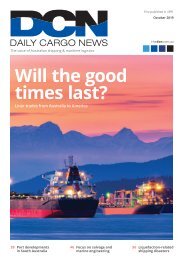DCN September Edition 2019
Create successful ePaper yourself
Turn your PDF publications into a flip-book with our unique Google optimized e-Paper software.
WESTERN AUSTRALIA<br />
Port Hedland is the largest port by tonnage in Australia<br />
In addition to CROP, ground-breaking modelling has increased<br />
declared depth availability at Port Hedland by 71 centimetres.<br />
A Dynamic Under Keel Clearance system, which takes a wider look<br />
at tidal variations, combined with Portable Pilot Units which gives<br />
pilots the ability to see exactly where they are while transiting, have<br />
allowed for a minimum clearance of 90 centimetres under vessels.<br />
Mr Johnston says that extra clearance will make the port more<br />
attractive to customers given that every 10 centimetres of clearance<br />
equates to an extra 1200 tonnes of cargo on a large iron ore carrier.<br />
The infrastructure at the Port of Port Hedland has also been<br />
boosted by a state-of-the art Integrated Marine Operations Centre<br />
which will replace the old shipping control tower.<br />
Mr Johnston says the capital expenditure in the harbour sends a<br />
signal to landside infrastructure operators that the port is ready to<br />
do bigger business.<br />
“They are not going to invest unless it can be proven we have the<br />
channel capacity. What we are doing is showing that we have the<br />
capacity to handle much more,” he says.<br />
Total throughput at the Port of Port Hedland for 2018-19 was<br />
down 1% year on year to 513.3 million tonnes, slightly better than<br />
the Port of Dampier, where the total throughput was down 2% year<br />
on year to 172.9 million tonnes.<br />
The figures were not helped by Cyclone Veronica, which shut<br />
down the Port of Port Hedland for 92.5 hours, the Port of Dampier<br />
for 132 hours, and the Port of Ashburton for 109.5 hours.<br />
“There was no damage. You get minor damage but nothing very<br />
serious. But that’s one of the biggest shutdowns I’ve seen in eight<br />
and a half years,” Mr Johnston says.<br />
“Right across the Pilbara, the effect was pretty sizeable in terms<br />
of stopping shipping for 10 or so days.”<br />
But barring cyclones, things are likely to be on the increase for<br />
the Pilbara ports, where projects like Fortescue’s Eliwanna mine<br />
and railway has been launched. The rail is expected to first load of<br />
iron ore to Port Hedland in December 2020.<br />
Mr Johnston is reluctant to comment on specific mining<br />
projects but the PPA is well positioned to take advantage of what he<br />
described as renewals of mines in the region.<br />
“I think we’ll start to see right across the board a significant uplift<br />
in project cargo and associated cargo in the next year or two,” he says.<br />
MIXED BAG FOR MID WEST<br />
The 2018-19 financial year was a year of small but hard-won gains<br />
for the Port of Geraldton where strategies have been put in place for<br />
significant growth into the future.<br />
At the Port of Geraldton, the number of a vessel movements rose by<br />
13 in the last financial year to 414 and total throughput was 15.905m<br />
tonnes, up on 15.886m tonnes the previous year.<br />
The port has had to dig deep since the completion of Mount<br />
Gibson Iron’s mining operations at Mount Gibson, which exported<br />
from Geraldton.<br />
Mid West Ports Authority CEO Rochelle Macdonald says a<br />
breakdown at a mine site also led to a reduction in iron ore trucks<br />
delivering to the port.<br />
But Dr Macdonald says an increase in grain shipments offset the<br />
decrease in iron ore shipments.<br />
The Port of Geraldton also picked up lower grade cargo, such as<br />
haematite, which made up for some of the lost business.<br />
However, in what can be a frustrating game of swings and<br />
roundabouts, weather events towards the end of the financial year<br />
obstructed the port’s ability to make up for lost ground.<br />
DIVERSITY IN PORTS<br />
Mid West Ports Authority’s CEO Rochelle<br />
Macdonald does not see her appointment as a<br />
sign that gender ratios in Australian ports are<br />
about to change.<br />
Dr Macdonald says ports are still an “old school<br />
industry” but the number of women working in<br />
ports is increasing.<br />
She says women are winning positions based<br />
on merit rather than their gender and cites the<br />
executive team of Mid West Ports as an example.<br />
“I have myself and three other women and two<br />
gentlemen. We have more females than males.<br />
I don’t know of any other panel in Australia that<br />
has that gender diversity,” she says.<br />
But Dr Macdonald says diversity is not just<br />
about numbers. She says businesses<br />
can best respond to the community<br />
by having diversity of opinion,<br />
which requires diversity within the<br />
workforce.<br />
Dr Macdonald does not promote<br />
any particular path for women into the<br />
industry.<br />
“In my port, women can do anything.<br />
If they want to become a sparky, a<br />
boilermaker, it’s open. It’s all about the<br />
best person for the job,” she says.<br />
The Mid West Ports Authority will<br />
hold an open day later this year to<br />
promote career opportunities.<br />
Dr Rochelle Macdonald, CEO,<br />
Mid West Ports Authority<br />
Philip Schubert; Mid West Ports Authority<br />
40 <strong>September</strong> <strong>2019</strong><br />
thedcn.com.au
















